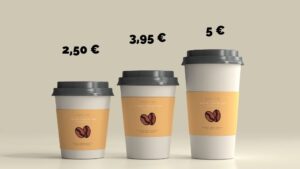When it comes to running a successful e-commerce business, one of the most important decisions you’ll make is how to price your products. While the cost of your goods and your desired profit margin play a role, the true science of pricing involves understanding consumer psychology. The right pricing strategy can make or break a sale – and in many cases, the difference between a customer choosing your product over a competitor’s. Recent studies show that pricing strategies influence up to 75% of purchase decisions, according to research published in Capital Online Shopping. Consumers don’t just look at price tags, they react to how those prices are presented.
In this blog post, we’ll dive into psychological pricing strategies for e-commerce and explore how leveraging these techniques can help maximize sales and boost your bottom line. Whether you’re a seasoned Shopify store owner or just starting, these tactics can elevate your pricing game to the next level.
1. Charm Pricing: Why .99 Win Sales
Have you ever noticed that most products are priced at $19.99 instead of $20? This pricing strategy, called charm pricing, is one of the most widely used psychological tricks in the science of pricing. It’s a tactic that works because of a mental bias known as left-digit anchoring.
Why It Works:
When consumers see a price like $19.99, their brains focus on the first digit, “1,” and they perceive the product as costing closer to $19 rather than $20, even though the actual difference is just one cent. This phenomenon works because we tend to round down the first number we see, making the product seem more affordable.
Real-World Example:
Retailers like Amazon, Walmart, and even luxury brands use this strategy, regardless of the price point. Studies show that products priced with charm pricing convert at higher rates than those priced at whole numbers. This small change can have a significant impact on the success of your e-commerce business.
2. Anchoring: How Price Benchmarks Drive Sales
One of the most effective ways to influence how customers perceive the value of a product is through anchoring. This psychological strategy involves presenting a high reference price (anchor) to make your actual product price seem like a better deal in comparison.
Why It Works:
When customers are exposed to a higher price first, they automatically compare subsequent prices to that anchor. As a result, even if the “sale” price is still higher than what the consumer would typically pay, the anchoring effect makes it appear more affordable.
Real-World Example:
Think about a high-end item on sale for $200, but with the original price tag marked at $500. In this case, the $200 price point is perceived as a bargain due to the high anchor price. This strategy is particularly effective in luxury e-commerce, where products like jewelry or designer goods often use this tactic to boost sales.
3. The Decoy Effect: Steering Customers to Buy

Have you ever been offered a product that seemed like a better deal because a third, less attractive option was added to the mix? This is the decoy effect, a psychological pricing strategy where a middle option is intentionally placed between a lower-priced and higher-priced item, making the middle option appear as the best value.
Why It Works:
By adding a decoy product, you’re not only creating contrast but also nudging customers toward a particular price point. It makes the middle option seem like the smartest choice, even if it might not be the most affordable or the most expensive.
Real-World Example:
A popular example of this is the subscription pricing model seen in SaaS (Software as a Service) businesses. A company might offer:
- Option 1: Basic Plan at $10/month
- Option 2: Pro Plan at $30/month
- Option 3: Premium Plan at $40/month (decoy)
The Pro Plan at $30 might seem like the best deal because it offers more value than the Basic Plan, but isn’t as expensive as the Premium Plan. The decoy, priced at $40, makes the middle option look much more appealing.
4. Price Bundling: Giving More for Less
Product bundling is a classic psychological strategy that e-commerce businesses often use to increase perceived value. Bundling involves offering multiple products together at a lower combined price than if they were purchased individually.
Why It Works:
Consumers love the idea of getting “more for their money.” Bundles tap into the contrast effect, which encourages customers to buy more because they believe they’re getting a good deal.
Real-World Example:
Think of a retailer offering a “Buy 2, Get 1 Free” deal. While the discount may seem small on the surface, the perceived value is much greater because customers feel like they are receiving something for free. Additionally, product bundling often leads to increased average order value (AOV), which is crucial for profitability.
5. Creating FOMO with Scarcity and Urgency
People are naturally drawn to limited-time offers, special promotions, or products in short supply. The scarcity principle is a powerful psychological tool that can be used to create urgency and drive quicker decision-making.
Why It Works:
Humans are hardwired to fear missing out on opportunities, and this instinct can be leveraged in pricing strategies to push customers toward purchasing before they lose the opportunity.
Real-World Example:
E-commerce giants like Amazon and Shopify often use countdown timers for flash sales or show limited stock notifications like “Only 2 left in stock!” These tactics prompt customers to make purchasing decisions quickly to avoid missing out, ultimately boosting sales.
6. The Left Digit Effect: Why Whole Numbers Fail
While charm pricing (ending prices in .99) is effective for many e-commerce products, there are cases where using a whole number is more beneficial. This is known as the left digit effect.
Why It Works:
When customers see a whole number price, such as $100 or $500, it can create a perception of higher quality and more luxury. This is especially important for premium and high-end products.
Real-World Example:
For luxury items or premium goods, such as designer watches, handbags, or high-end electronics, using round pricing numbers like $1,000 rather than $999.99 can increase perceived value. Customers associate whole numbers with quality and prestige, making them more likely to view these products as worth the investment.
7. Free Shipping: The Trick Behind the Offer

Who doesn’t love the idea of free shipping? The word “free” is one of the most powerful tools in the science of pricing, as it triggers a positive emotional response. Offering free shipping can significantly increase your conversion rate and encourage consumers to complete a purchase.
Why It Works:
Shipping fees are often seen as an extra cost that customers have to pay on top of the product price. By offering free shipping, you remove this perceived barrier, which can make customers more willing to buy.
However, e-commerce businesses often raise prices slightly to offset the cost of free shipping, which doesn’t necessarily hurt profitability but enhances the perceived value of the deal.
Real-World Example:
E-commerce giants like Zappos and Amazon have mastered the art of free shipping. They’ve built an entire customer experience around the concept, knowing that the “free shipping” offer creates a sense of value and urgency, driving more sales.
8. Psychological Pricing for Emotional Purchases
Pricing strategies aren’t just about numbers, they also tap into the emotional side of consumer decision-making. Emotional pricing involves pricing products in a way that aligns with the customer’s emotions, desires, and psychological triggers.
Why It Works:
People often make purchase decisions based on emotions, not logic. Emotional pricing focuses on understanding the desires of your target audience and using pricing to satisfy those emotions. Whether it’s the joy of owning a luxury item or the relief of getting a great deal, emotional pricing strategies work by connecting the price to the emotional payoff of purchasing.
Real-World Example:
Luxury brands, like Rolex or Louis Vuitton, create an aura of exclusivity and status with their high price points. Their customers are willing to pay these premium prices because of the emotional gratification associated with owning these products.
Conclusion: Mastering The Science of Pricing
Pricing isn’t just about profit margins, it’s about influencing decisions. The right psychological strategies, like charm pricing, anchoring, and urgency, can shape how customers perceive value and drive more sales. For Shopify and e-commerce businesses, a smart pricing strategy can transform your bottom line, whether you sell budget-friendly or premium products.
At Frontlevels, we help businesses unlock pricing potential for sustained growth. Ready to optimize your strategy?

